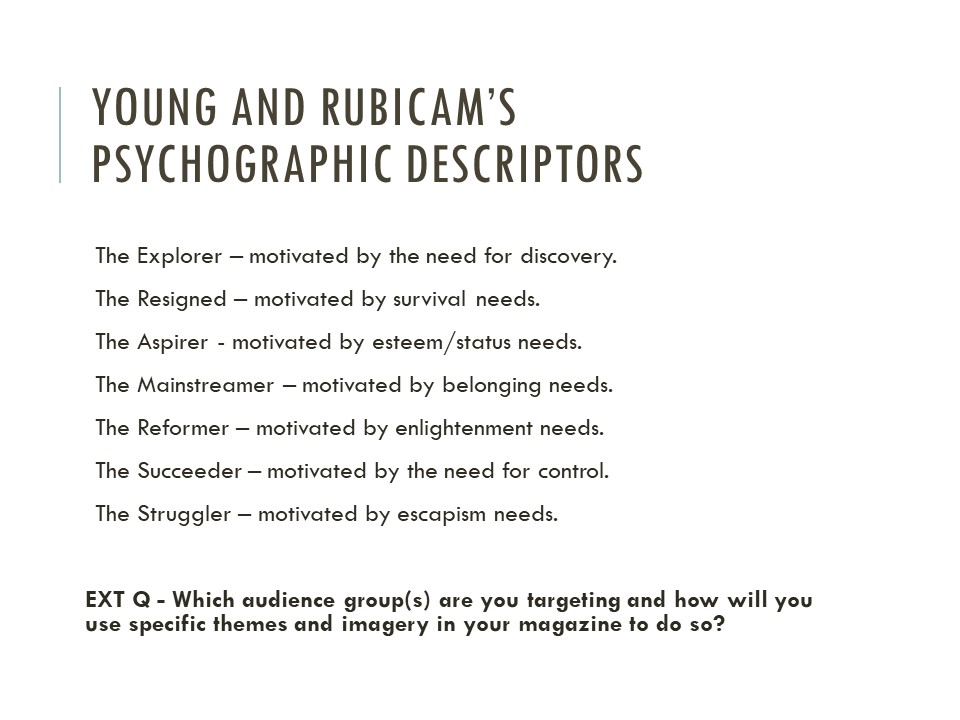Category Archives: Exam Prep
Filters
Lasswell and the hypodermic model
Hypodermic model – people are passive consumers of media
Harold Lasswell wrote “Propaganda in the World War” – and highlighted “subtle poison, which industrious men injected into the veins of a staggering people until the smashing powers… knocked them into a submission.”

audience theory
Hypodermic model (passvie consumption)
its passive and about changing behaviour, a linear consumptive model.
Harold Lasswell wrote a book called Propaganda Technique in the World war written in 1927 . it highlighted the brew of ‘subtle poison, which industrious men injected into the veins of a staggering people until the smashing powers . . . knocked them into submission’

audience theory
Hypodermic model (passive consumption)
Media consumption was often traced back to Harold Lasswell. In 1972 he wrote Propaganda Technique in the World War. He spoke about individuals being influenced using the term ‘Injected’.
The Hypodermic model: Telling someone to do something and they listen through media.
Passive Consumption: The idea of people being drip fed an idea or belief to slowly change someone’s view on a subject over time through media.

Audience: theories and approaches
in 1927 writer Harold Laswell who wrote the Propaganda Technique in the World War where he talks about a ‘brew of ‘subtle poison, which industrious men injected (passive consumption) into the veins of a staggering people until the smashing powers . . . knocked them into submission’’ this also relates to the hypodermic model where this subtle poison that is injected (passive consumption) to change the behavioural pattern within someone and changing them to be something different
Audience Theory Notes
Hypodermic model (passive consumption)
Harold Lasswell was a key figure in the development of understanding how media is consumed. In 1927 he wrote Propaganda Technique in the World War which “highlighted the brew of ‘subtle poison, which industrious men injected into the veins of a staggering people until the smashing powers . . . knocked them into submission’” – which effectively means, how did the leaders in the first world war convince civilians that war was worth fighting and that it was worth dying for?

Two Step Flow of Communication (active consumption)
At the same time Paul Lazarfeld recognised that a simple, linear model may not be sufficiently complex to understanding the relationship between message sent > message received. As such, in 1948 he developed the Two Step Flow model of communication.

QUANTITATIVE v QUALITATIVE
Approaches to audience theory will either adopt a QUANTITATIVE ie number based approach (so counting sales, audience figures, costs etc) OR QUALITATIVE (a more individual interpretative approach considering not how many, but why audiences consume or engage)
There are many different categories of people, as described by Young and Rubicam:

| RESEARCH PRODUCT 1 (Cristiano Ronaldo Shampoo) | RESEARCH PRODUCT 2 (Nivea Shampoo) | MY PRODUCT (Deodorant) | |
| Quantitative | Middle/upper class, 16-25 year old men, lots of disposable income, relatively decent education | Middle class, 16-50 year old men, fair disposable income, fair education | Lower/Middle class, 12-40 year old males, fair amount of disposable income, fair education |
| Qualitative | Mainstreamer, Aspirer | Mainstreamer, Reformed | Mainstreamer, Struggler |
Audience Theory
Hypodermic model based on passive consumption which is significant to advertising. The idea of telling someone to do something and they do it.
Harold Laswell – Propaganda Technique in the World War “subtle poison, which industrious men injected into the veins of a staggering people until the smashing powers… knocked them into submission”. As Martin Moore notes, Laswell, as a behavioural scientist researching areas connected with political communication and propaganda, believed each government had ‘manipulated the mass media in order to justify its actions’ in World War 1.
Shannon and Weaver in 1949, as the Transmission model of Communication, which included other elements, such as NOISE, ERROR, ENCODING and FEEDBACK.
In other words, there is the suggestion that the process of sending and receiving a message is NOT clear-cut, predictable or reliable and is dependent on a range of other factors that need to be taken into consideration.

audience theory
hypodermic model (passive consumption)-
Early theoretical work on the relationship of media consumption are often traced back to Harold Lasswell, who developed the theoretical tool of ‘content analysis’ and in 1927 wrote Propaganda Technique in the World War which highlighted the brew of ‘subtle poison, which industrious men injected into the veins of a staggering people until the smashing powers . . . knocked them into submission’ . As Martin Moore notes, Lasswell, as a behavioural scientist researching areas connected with political communication and propaganda, believed each government had ‘manipulated the mass media in order to justify its actions’ in World War 1.
To illustrate his hypothesis, in 1948 he developed a linear model of communication, one that breaks down the line of communication from point A to point B, in which the SENDER is transferring a MESSAGE, through a MEDIUM (eg Print, radio, TV, etc) that has a direct effect on the RECEIVER.



if i had a product which i was advertising, i would employee people with the same aspects on the product, if they were truly passionate about the product they would be able sell it well.😘
INVICTUS AD INSPECTION

Audience Theory
hypodermic model (passive consumption)
Early theoretical work on the relationship (or effects) of media consumption are often traced back to Harold Laswell.
After the end of WWII, social science researchers began to investigate the way in which communication – and particularly, political communication – was used to disseminate propaganda.
1927 wrote Propaganda Technique in the World War which highlighted the brew of ‘subtle poison, which industrious men injected into the veins of a staggering people until the smashing powers . . . knocked them into submission’.


If I had a product to advertise I would employ





